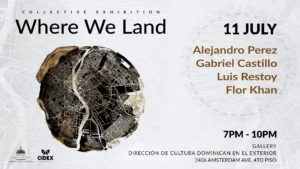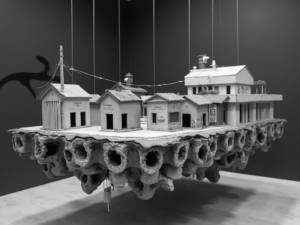By Juan Butten
A week ago, I decided to make one more call to Strand Book Store. For a couple of years, I had been searching for a particular book: “Brutal Beauty,” the iconic work by Jean Dubuffet. When the person on the other end of the line confirmed that it had finally arrived, I felt a slight shiver of excitement. That same afternoon, I took the train to pick it up. There it was: the hardcover edition, with its 268 pages—a true luxury in my hands. The introduction by Eleanor Nairne only enhanced the experience.
As I opened the book, I immersed myself in the essence of Dubuffet’s artistic philosophy and his appreciation for marginal art. I couldn’t help but remember my late friend, Carlos Goico, and his devils. Dubuffet, a French painter and sculptor, is known for his unconventional approach to art, rejecting established norms in favor of an aesthetic that celebrates the primitive, the raw, and the authentic. His radical vision resonates deeply in a world that often clings to polished and conventional standards of beauty.
The term “brutal” in the title led me to reflect on “brut” or “raw” art. Dubuffet had a special admiration for the creations of untrained artists, often marginalized by society. People with mental disabilities or those living in social isolation bring an authenticity that is often lacking in the works of more conventional artists. For Dubuffet, art should be a direct reflection of human experience, free from the constraints imposed by the traditional art world.
On the train, despite it being very crowded, I managed to find a seat and began to enjoy the feel of the pages. I could see how his work encompassed a spectrum of human emotions, from joy to despair, expressed through unconventional techniques and materials. It was a visual style that was both visceral and poetic, challenging the notion that art must be beautiful in the traditional sense.
A guy sitting right next to me lit up a blunt, which only added a deeper sense to my reading. Dubuffet’s work arises in a cultural and social context marked by significant changes. As I flipped through the pages, I watched the smoke curl between them. In the post-war period, Western art began to question established forms of artistic expression, driven by movements like surrealism and dadaism. “Brutal Beauty,” then, presents itself as a response to the disillusionment of its time. By rejecting notions of ideal beauty, Dubuffet aligns himself with a spirit of rebellion that characterizes much of contemporary art. His interest in the art of the marginalized resonated with the social concerns of his time, proposing a revaluation of silenced voices.
As I continued reading, the train stopped and a discussion began between a Chinese man and a Latino who sat next to me. I didn’t care; I remained absorbed in the book. The smoker got off at 59th Street–Columbus Circle station, and I stayed focused on my reading, where I realized that “Brutal Beauty” was not just an aesthetic manifesto but also a call for inclusion and appreciation of diverse forms of creativity. Despite the outside conversation, I pondered aloud about Dubuffet’s undeniable influence on contemporary art. His approach to raw art has inspired many artists seeking to explore authenticity in their work. Movements like neo-expressionism and outsider art recognize him as a precursor celebrating diversity in artistic creation.
Seven stops later, I arrived at my destination and closed the book. As I exited the station, I reflected on what I had read. I felt that “Brutal Beauty” is essential for discussing the relationship between art and madness. I got home and continued to flip through the book, understanding that Dubuffet demonstrated how human suffering can lead to forms of beauty that, while difficult to accept, are equally valid and significant.
Days later, I finished reading it and revisited it several times. I realized that “Brutal Beauty” is more than a collection of works; it is a manifesto that challenges our perceptions of art and beauty. Through its celebration of the raw and the authentic, Dubuffet invites us to reconsider what we value in artistic creation. His legacy endures, reminding us that beauty can be found in the most unexpected places and that every voice, regardless of its origin, deserves to be heard. In a world that favors the polished and conventional, “Brutal Beauty” challenges us to look beyond and find beauty in the brutally human.









